Fletcher Creek is a rehabilitated fen wetland - a former quarry that has now become an example of one of Ontario’s rarer habitat types. It is an excellent spot for dragonflies (which is why, of course, we were there).
Dragonflies and damselflies vary in the timing and season of their adult flight period, so even the space of a few weeks made a considerable difference as to which species we were likely to see.
Some of the species we came across, of course, were the same we had seen nearby a month earlier (see my previous post). They included the lovely Ebony Jewelwing (Calopteryx maculata)...
...and the ubiquitous Eastern Forktail (Ischnura verticalis), which flies well into the autumn. Perched male Eastern Forktails frequently wave their abdomens back and forth, presumably to enhance the display effect of its bright blue tip.
This is an Eastern Forktail too - an immature female...
...and an even more immature, or teneral, individual, only recently emerged and still to gain adult colouration.
This is an Eastern Forktail too - an immature female...
...and an even more immature, or teneral, individual, only recently emerged and still to gain adult colouration.
However, this one could be a Marsh Bluet (Enallagma ebrium), based on the pattern of blue and black on the abdominal segments.
We had the good fortune to run across another dragonfly enthusiast, who was far better informed than I about identification matters. He pointed out that these particular individuals (and others of their type) were Boreal Bluets (Enallagma aspersum). I believe this was based on prior knowledge of what was in the area, as these insects are almost impossible to identify definitively without a close examination of the male’s genitalia.
The Violet Dancer (Argia fumipennis violacea) is much easier to identify. No other damselfly in Ontario is this colour. They have a particular penchant for perching on rocks, pieces of wood or gravel pathways.
This is the local representative among the three well-marked subspecies of the Variable Dancer (Argia fumipennis); the other two look quite different.
Among the dragonflies at Fletcher Creek we found a number of species we had missed on our June excursions. They included the Four-spotted Skimmer (Libellula quadrimaculata), a widespread species that also occurs in Europe.
It’s cousin the Widow Skimmer (Libellula luctuosa) is one of our handsomest dragonflies. This is a young male, with the distinctive wing pattern of the adult but without the heavy bluish-white pruinosity, or powdery covering, concealing his yellow-striped abdomen.
Whitefaces (Leucorrhinia spp) are smallish dragonflies with a distinctly northern distribution in both the Old and New Worlds. The Dot-tailed Whiteface (Leucorrhinia intacta) is probably the commonest of the seven North American species, and is most easily identified by the yellow spot on the top of its seventh abdominal segment (counting, as odonatologists do, from the front to the back).
Whitefaces are variable and tricky to identify, but I believe this one is a Frosted Whiteface (Leucorrhinia frigida) based on the powdery 'frosting', or pruinosity, on the upper side of ts abdomen (as opposed to on the underside, a in the Dot-tailed Whiteface).
The prize of the day, for me, was my first decent sighting of a Black Saddlebags (Tramea lacerata) at the ege of one of the larger ponds. This is not a rare species, but one that I had been unable to get more than a glimpse of before. Like other Tramea species, it has a dark patch on the base of the hindwing (the so-called saddlebag).
Black Saddlebags are not only wide-ranging (they have even reached Hawaii) but they are highly migratory. Numbers have been seen massing on the shores of Lake Ontario in autumn along with Ontario's other major dragonfly migrant, the Common Green Darner (Anax junius), preparing to strike out for the south. Like the better-known Monarch Butterfly (Danaus plexippus), the dragonflies that leave our shores will not return; it is their offspring that will make the spring journey northward.
Though Ryan and I were on an odonatological expedition, we did not ignore the other creatures on the reserve. We watched butterflies too, including this Eastern Comma (Polygonia comma)...
... and a particularly lovely little insect, the Baltimore Checkerspot (Euphydryas phaeton). There is nothing else quite like it in eastern North America, though there are a number of other checkerspots, members of the nymphalid subfamily Melitaeinae, in the west.
The Pickerel Frog (Lithobates palustris) resembles the more common leopard frogs, but is distinguished by its greyish-brown ground colour and the squarish, rather than round, spots on its back. It gets its name, I am sorry to say, from the tendency of pickerel fishers to use it for bait.
Undoubtedly some of the Pickerel Frogs that are not devoured by their fishy namesakes will end up in the stomachs of Northern Water Snakes (Nerodia sipedon sipedon). This is one of our commonest snakes, and (for the benefit of any Ontario readers I may have) it is not a Water Moccasin (Agkistrodon piscivorus) (which does not occur in Ontario) and is not venemous.
Finally, just to show that even though it was July we had not given up birding altogether, here is a Rufous-sided Towhee (Pipilo erythrophthalmus) singing from the top of a shrub. Ryan and I are all-around naturalists, we are.




















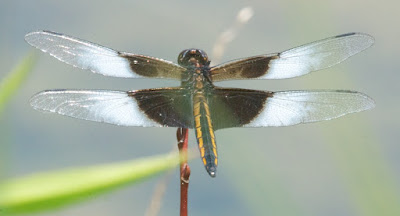
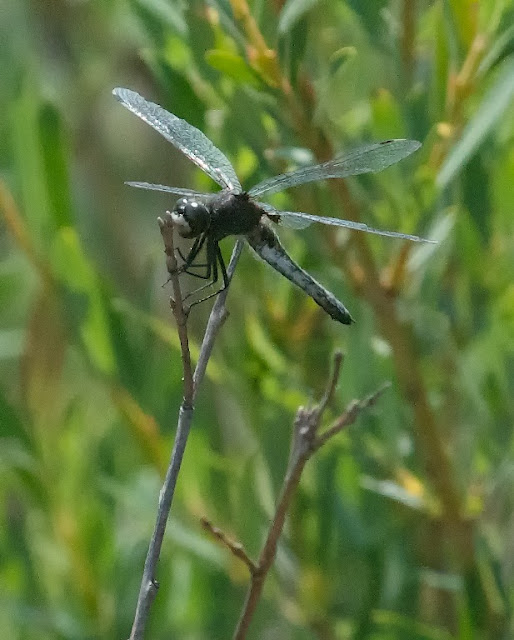





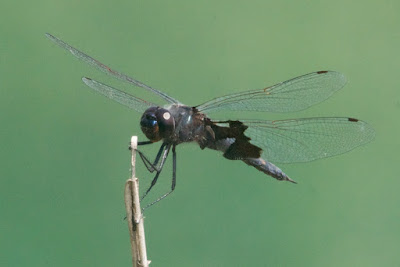


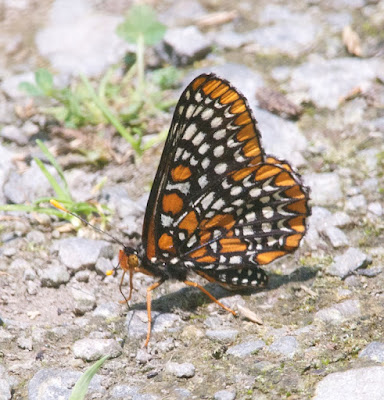



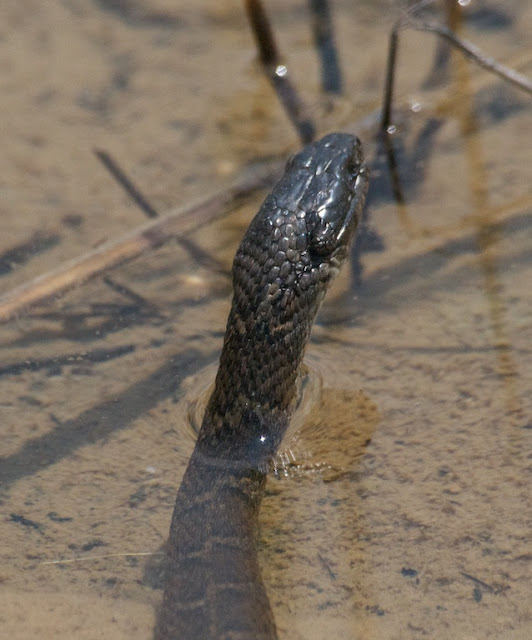




No comments:
Post a Comment